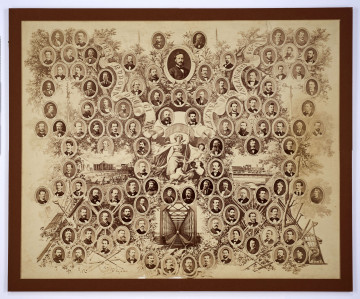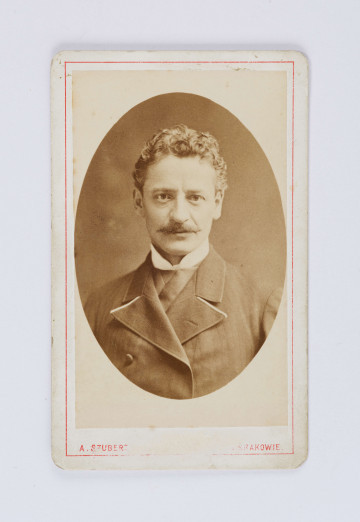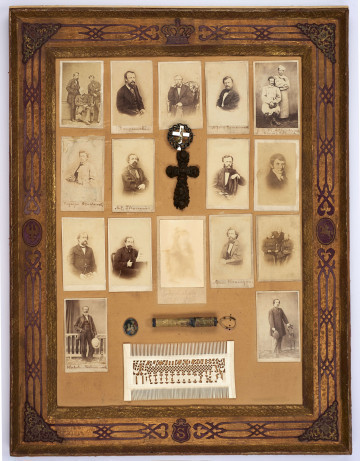
Table of the builders of the Vistula iron road
1876
National Museum in Lublin
Part of the collection: Photographs documenting the construction of the Vistula River Railway (1876–1878)
The construction of the Żelazna Nadwiślańska Road allowed for the development of industry, facilitated the transport of goods and travel. It significantly influenced the development of spa tourism. The governorate authorities, seeing the need to build a railway, got involved in this project.
Tableau was created to commemorate the railway workers. Due to the lack of signatures, not all persons can be identified, but one of them is Dr. Wacław Lasocki, chief physician of the Vistula railway in 1875–1878. He was a great patriot, a capable man, and committed to the tasks entrusted to him. He wanted to serve his enslaved homeland with his work.
He was born in 1837 in the village of Bisówka, in the former Wołyń Province. After graduating from the gymnasium in Żytomierz, he began medical studies in Kiev (1854–1859). Then he started working at the internal surgery clinic at the Pechersk military hospital in Kiev. In 1861, he married Maria Milanowska and moved to the Oleśniki farmhouse, where he ran a farm. For helping the January insurgents, he was sentenced to death, which was converted into exile and confiscation of the property. During a two-year trip to Siberia, he helped in the treatment of typhus and smallpox epidemics that the exiles suffered of. After reaching Usol in 1866, he was granted an amnesty, he did not have to work hard in the salt mine, but he was not able to return to the country yet. He worked as a doctor in the local hospital.
In 1873 he left for Warsaw and became the chief doctor of the Żelazna Nadwiślańska Road.
He was a co-founder of the Medicinal Institute in Nałęczów. In 1898 he settled permanently in the town. After his wife's death, he devoted himself to collecting. He collected graphics, numismatic items, natural specimens and ethnographic objects. He was a co-founder of the museum in Nałęczów and its curator. He donated his collections to various institutions, including the Lublin Museum. Many items of his writing legacy, diaries, lectures on medicine, manuscripts from the time of the exile and photographs are in the Provincial Public Library. H. Łopaciński in Lublin. In 1934 and 1937 he published Wspomnienia z mojego życia [Memoirs of my life].
Author / creator
Dimensions
cały obiekt: height: 48,5 cm, width: 59 cm
Object type
tableau
Technique
photographic print
Material
paper
Creation time / dating
Creation / finding place
Owner
The National Museum in Lublin
Identification number
Location / status

1876
National Museum in Lublin

1882
National Museum in Lublin

1844 — 1865
National Museum in Lublin
DISCOVER this TOPIC
Museum of King Jan III's Palace at Wilanów
DISCOVER this PATH
Educational path